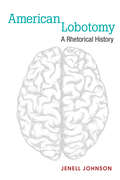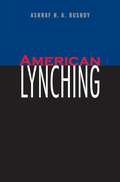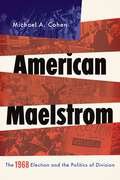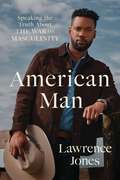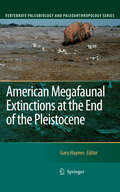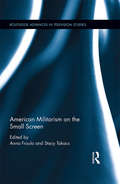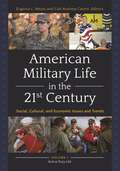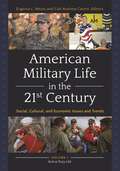- Table View
- List View
American Life Writing and the Medical Humanities: Writing Contagion
by Samantha Allen WrightAmerican Life Writing and the Medical Humanities: Writing Contagion bridges a gap in the market by linking the medical humanities with disability studies. It examines how Americans have used life writing to record epidemic disease throughout history. Starting in the late 1800s with Yellow Fever and ending with the 2014-2016 Ebola outbreaks, the author tracks how American life writing changed literature, history, and medicine. Although the illness narrative genre became more popular in the mid-20th century, Americans have been writing illness narratives throughout American history. Writing Contagion focuses on American epidemics to see how these outbreaks spurred Americans into telling their stories. Looking at book-length narratives of illness and disability, the author traces the development and lineage of illness narratives from early American nonfiction writing, to literary modernism and to contemporary memoir. Viewing illness narratives as intensely interdisciplinary, the author argues that to understand both the importance and influence of this genre within American literature, illness narratives need to be read through literary, disability studies, and medical humanities frameworks to challenge ableist assumptions and demonstrate how illness narratives are of both historical and literary importance in America.
American Literature and American Identity: A Cognitive Cultural Study from the Civil War to the Twenty-First Century (Narrative Theory and Culture)
by Patrick Colm HoganIn recent years, cognitive and affective science have become increasingly important for interpretation and explanation in the social sciences and humanities. However, little of this work has addressed American literature, and virtually none has treated national identity formation in influential works since the Civil War. In this book, Hogan develops his earlier cognitive and affective analyses of national identity, further exploring the ways in which such identity is integrated with cross-culturally recurring patterns in story structure. Hogan examines how authors imagined American identity—understood as universal, democratic egalitarianism—in the face of the nation’s clear and often brutal inequalities of race, sex, and sexuality, exploring the complex and often ambivalent treatment of American identity in works by Charlotte Perkins Gilman, Eugene O’Neill, Lillian Hellman, Djuna Barnes, Amiri Baraka, Margaret Atwood, N. Scott Momaday, Spike Lee, Leslie Marmon Silko, Tony Kushner, and Heidi Schreck.
American Literature and American Identity: A Cognitive Cultural Study from the Civil War to the Twenty-First Century (Narrative Theory and Culture)
by Patrick Colm HoganIn recent years, cognitive and affective science have become increasingly important for interpretation and explanation in the social sciences and humanities. However, little of this work has addressed American literature, and virtually none has treated national identity formation in influential works since the Civil War. In this book, Hogan develops his earlier cognitive and affective analyses of national identity, further exploring the ways in which such identity is integrated with cross-culturally recurring patterns in story structure. Hogan examines how authors imagined American identity—understood as universal, democratic egalitarianism—in the face of the nation’s clear and often brutal inequalities of race, sex, and sexuality, exploring the complex and often ambivalent treatment of American identity in works by Charlotte Perkins Gilman, Eugene O’Neill, Lillian Hellman, Djuna Barnes, Amiri Baraka, Margaret Atwood, N. Scott Momaday, Spike Lee, Leslie Marmon Silko, Tony Kushner, and Heidi Schreck.
American Lobotomy: A Rhetorical History (Corporealities: Discourses Of Disability)
by Jenell JohnsonAmerican Lobotomy studies a wide variety of representations of lobotomy to offer a rhetorical history of one of the most infamous procedures in the history of medicine. The development of lobotomy in 1935 was heralded as a “miracle cure” that would empty the nation’s perennially blighted asylums. However, only twenty years later, lobotomists initially praised for their “therapeutic courage” were condemned for their barbarity, an image that has only soured in subsequent decades. Johnson employs previously abandoned texts like science fiction, horror film, political polemics, and conspiracy theory to show how lobotomy’s entanglement with social and political narratives contributed to a powerful image of the operation that persists to this day. The book provocatively challenges the history of medicine, arguing that rhetorical history is crucial to understanding medical history. It offers a case study of how medicine accumulates meaning as it circulates in public culture and argues for the need to understand biomedicine as a culturally situated practice.
American Lynching
by Ashraf H. RushdyAfter observing the varying reactions to the 1998 death of James Byrd Jr. in Texas, called a lynching by some, denied by others, Ashraf Rushdy determined that to comprehend this event he needed to understand the long history of lynching in the United States. In this meticulously researched and accessibly written interpretive history, Rushdy shows how lynching in America has endured, evolved, and changed in meaning over the course of three centuries, from its origins in early Virginia to the present day.Rushdy argues that we can understand what lynching means in American history by examining its evolution—that is, by seeing how the practice changes in both form and meaning over the course of three centuries, by analyzing the rationales its advocates have made in its defense, and, finally, by explicating its origins. The best way of understanding what lynching has meant in different times, and for different populations, during the course of American history is by seeing both the continuities in the practice over time and the specific features in different forms of lynching in different eras.
American Maelstrom: The 1968 Election and the Politics of Division (Pivotal Moments in World History)
by Michael A. CohenIn his presidential inaugural address of January 1965, Lyndon B. Johnson offered an uplifting vision for America, one that would end poverty and racial injustice. Elected in a landslide over the conservative Republican Barry Goldwater and bolstered by the so-called liberal consensus, economic prosperity, and a strong wave of nostalgia for his martyred predecessor, John F. Kennedy, Johnson announced the most ambitious government agenda in decades. Three years later, everything had changed. Johnson's approval ratings had plummeted; the liberal consensus was shattered; the war in Vietnam splintered the nation; and the politics of civil rights had created a fierce white backlash. A report from the National Committee for an Effective Congress warned of a "national nervous breakdown." The election of 1968 was immediately caught up in a swirl of powerful forces, and the nine men who sought the nation's highest office that year attempted to ride them to victory-or merely survive them. On the Democratic side, Eugene McCarthy energized the anti-war movement; George Wallace spoke to the working-class white backlash; Robert Kennedy took on the mantle of his slain brother. Entangled in Vietnam, Johnson, stunningly, opted not to run again, scrambling the odds. On the Republican side, 1968 saw the vindication of Richard Nixon, who outhustled Nelson Rockefeller, Ronald Reagan, and George Romney by navigating between the conservative and moderate wings of the Republican Party. The assassinations of the first Martin Luther King, Jr., and then Kennedy, seemed to push the country to the brink of chaos, a chaos reflected in the Democratic Convention in Chicago, a televised horror show. Vice President Hubert Humphrey emerged as the nominee, and, finally liberating himself from Johnson's grip, nearly overcame the lead long enjoyed by Nixon, who, by exploiting division and channeling the national yearning for order, would be the last man standing. In American Maelstrom, Michael A. Cohen captures the full drama of this watershed election, establishing 1968 as the hinge between the decline of political liberalism, the ascendancy of conservative populism, and the rise of anti-governmental attitudes that continue to dominate the nation's political discourse. In this sweeping and immersive book, equal parts compelling analysis and thrilling narrative, Cohen takes us to the very source of our modern politics of division.
American Maelstrom: The 1968 Election and the Politics of Division (Pivotal Moments in World History)
by Michael A. CohenIn his presidential inaugural address of January 1965, Lyndon B. Johnson offered an uplifting vision for America, one that would end poverty and racial injustice. Elected in a landslide over the conservative Republican Barry Goldwater and bolstered by the so-called liberal consensus, economic prosperity, and a strong wave of nostalgia for his martyred predecessor, John F. Kennedy, Johnson announced the most ambitious government agenda in decades. Three years later, everything had changed. Johnson's approval ratings had plummeted; the liberal consensus was shattered; the war in Vietnam splintered the nation; and the politics of civil rights had created a fierce white backlash. A report from the National Committee for an Effective Congress warned of a "national nervous breakdown." The election of 1968 was immediately caught up in a swirl of powerful forces, and the nine men who sought the nation's highest office that year attempted to ride them to victory-or merely survive them. On the Democratic side, Eugene McCarthy energized the anti-war movement; George Wallace spoke to the working-class white backlash; Robert Kennedy took on the mantle of his slain brother. Entangled in Vietnam, Johnson, stunningly, opted not to run again, scrambling the odds. On the Republican side, 1968 saw the vindication of Richard Nixon, who outhustled Nelson Rockefeller, Ronald Reagan, and George Romney by navigating between the conservative and moderate wings of the Republican Party. The assassinations of the first Martin Luther King, Jr., and then Kennedy, seemed to push the country to the brink of chaos, a chaos reflected in the Democratic Convention in Chicago, a televised horror show. Vice President Hubert Humphrey emerged as the nominee, and, finally liberating himself from Johnson's grip, nearly overcame the lead long enjoyed by Nixon, who, by exploiting division and channeling the national yearning for order, would be the last man standing. In American Maelstrom, Michael A. Cohen captures the full drama of this watershed election, establishing 1968 as the hinge between the decline of political liberalism, the ascendancy of conservative populism, and the rise of anti-governmental attitudes that continue to dominate the nation's political discourse. In this sweeping and immersive book, equal parts compelling analysis and thrilling narrative, Cohen takes us to the very source of our modern politics of division.
American Man: Speaking the Truth about the War on Masculinity
by Lawrence JonesFox & Friends cohost Lawrence Jones delivers the common sense book America needs more than ever in this definitive takedown of the left&’s never-ending attacks on masculinity. A generation ago it was understood that men and women were unique, yet interdependent, and designed by God to be that way. Today, the woke crowd wants you to believe masculinity is &“toxic.&” In his first book, Lawrence embarks on a thorough examination of who is doing the attacking and why. Informed by his travels across the country for Fox News, Lawrence explains how confused progressives are about manhood—and how powerful the need is to set the record straight. Men, he argues, are indispensable to thriving families and prosperous societies, and the sooner men start acting like men, the better off we all will be. Packed with stories from his own life and work, Lawrence makes a persuasive case for the virtues of manliness—courage, resilience, godliness, and self-reliance among others. Lawrence challenges his fellow men to live up to their responsibilities as men and to fill the cultural void woke ideologues have been happy to exploit. In confronting the chaos of contemporary culture, Lawrence is forced to reexamine his own beliefs as he spurs an honest discussion about what it means to be a man in America. The book also includes candid, never-before-shared interviews conducted by Lawrence of his Fox News colleagues, like Sean Hannity, Mark Levin, Pete Hegseth, Will Cain, as well as other prominent voices like NFL great Ben Watson and actor Dean Cain. This insightful and uncompromising book from one of the country&’s fastest rising stars will enlighten and inspire readers—as it proves once and for all the crucial role men can and must play in American life today.
American Masculinities in Contemporary Documentary Film: Up Close Behind the Mask (Routledge Advances in Film Studies)
by Sara MartínMost documentaries deal with men, but what do they actually say about masculinity? In this groundbreaking volume Sara Martín analyses more than forty 21st-century documentaries to explore how they represent American men and masculinity. From Jennifer Siebel Newsom’s The Mask You Live In to Raoul Peck’s I Am Not Your Negro, this volume explores sixteen different faces of American masculinity: the good man, the activist, the politician, the whistleblower, the criminal, the sexual abuser, the wrongly accused, the dependent man, the soldier, the capitalist, the adventurer, the sportsman, the architect, the photographer, the musician, and the writer. The collective portrait drawn by the documentaries discloses a firm critical stance against the contradictions inherent in patriarchy, which makes American men promises of empowerment it cannot fulfill. The filmmakers’ view of American masculinity emphasizes the vulnerability of disempowered men before the abuses of the patriarchal system run by hegemonic men and a loss of bearings about how to be a man after the impact of feminism, accompanied nonetheless by a celebration of resilient masculinity and of the good American man. Firmly positioning documentaries as an immensely flexible, relevant tool to understand 21st-century American men and masculinity, their past, present, and future, this book will interest students and scholars of film studies, documentary film, American cultural studies, gender, and masculinity.
American Masculinities in Contemporary Documentary Film: Up Close Behind the Mask (Routledge Advances in Film Studies)
by Sara MartínMost documentaries deal with men, but what do they actually say about masculinity? In this groundbreaking volume Sara Martín analyses more than forty 21st-century documentaries to explore how they represent American men and masculinity. From Jennifer Siebel Newsom’s The Mask You Live In to Raoul Peck’s I Am Not Your Negro, this volume explores sixteen different faces of American masculinity: the good man, the activist, the politician, the whistleblower, the criminal, the sexual abuser, the wrongly accused, the dependent man, the soldier, the capitalist, the adventurer, the sportsman, the architect, the photographer, the musician, and the writer. The collective portrait drawn by the documentaries discloses a firm critical stance against the contradictions inherent in patriarchy, which makes American men promises of empowerment it cannot fulfill. The filmmakers’ view of American masculinity emphasizes the vulnerability of disempowered men before the abuses of the patriarchal system run by hegemonic men and a loss of bearings about how to be a man after the impact of feminism, accompanied nonetheless by a celebration of resilient masculinity and of the good American man. Firmly positioning documentaries as an immensely flexible, relevant tool to understand 21st-century American men and masculinity, their past, present, and future, this book will interest students and scholars of film studies, documentary film, American cultural studies, gender, and masculinity.
American Media and the Memory of World War II (Routledge Research in Cultural and Media Studies)
by Debra RamsayFor three generations of Americans, World War II has been a touchstone for the understanding of conflict and of America’s role in global affairs. But if World War II helped shape the perception of war for Americans, American media in turn shape the understanding and memory of World War II. Concentrating on key popular films, television series, and digital games from the last two decades, this book explores the critical influence World War II continues to exert on a generation of Americans born over thirty years after the conflict ended. It explains how the war was configured in the media of the wartime generation and how it came to be repurposed by their progeny, the Baby Boomers. In doing so, it identifies the framework underpinning the mediation of World War II memory in the current generation’s media and develops a model that provides insight into the strategies of representation that shape the American perspective of war in general.
American Media and the Memory of World War II (Routledge Research in Cultural and Media Studies)
by Debra RamsayFor three generations of Americans, World War II has been a touchstone for the understanding of conflict and of America’s role in global affairs. But if World War II helped shape the perception of war for Americans, American media in turn shape the understanding and memory of World War II. Concentrating on key popular films, television series, and digital games from the last two decades, this book explores the critical influence World War II continues to exert on a generation of Americans born over thirty years after the conflict ended. It explains how the war was configured in the media of the wartime generation and how it came to be repurposed by their progeny, the Baby Boomers. In doing so, it identifies the framework underpinning the mediation of World War II memory in the current generation’s media and develops a model that provides insight into the strategies of representation that shape the American perspective of war in general.
American Megafaunal Extinctions at the End of the Pleistocene (Vertebrate Paleobiology and Paleoanthropology)
by Gary HaynesThe volume contains summaries of facts, theories, and unsolved problems pertaining to the unexplained extinction of dozens of genera of mostly large terrestrial mammals, which occurred ca. 13,000 calendar years ago in North America and about 1,000 years later in South America. Another equally mysterious wave of extinctions affected large Caribbean islands around 5,000 years ago. The coupling of these extinctions with the earliest appearance of human beings has led to the suggestion that foraging humans are to blame, although major climatic shifts were also taking place in the Americas during some of the extinctions. The last published volume with similar (but not identical) themes -- Extinctions in Near Time -- appeared in 1999; since then a great deal of innovative, exciting new research has been done but has not yet been compiled and summarized. Different chapters in this volume provide in-depth resumés of the chronology of the extinctions in North and South America, the possible insights into animal ecology provided by studies of stable isotopes and anatomical/physiological characteristics such as growth increments in mammoth and mastodont tusks, the clues from taphonomic research about large-mammal biology, the applications of dating methods to the extinctions debate, and archeological controversies concerning human hunting of large mammals.
The American Middle Class: A Cultural History
by Lawrence R SamuelThe middle class is often viewed as the heart of American society, the key to the country’s democracy and prosperity. Most Americans believe they belong to this group, and few politicians can hope to be elected without promising to serve the middle class. Yet today the American middle class is increasingly seen as under threat. In The American Middle Class: A Cultural History, Lawrence R. Samuel charts the rise and fall of this most definitive American population, from its triumphant emergence in the post-World War II years to the struggles of the present day. Between the 1920s and the 1950s, powerful economic, social, and political factors worked together in the U.S. to forge what many historians consider to be the first genuine mass middle class in history. But from the cultural convulsions of the 1960s, to the 'stagflation' of the 1970s, to Reaganomics in the 1980s, this segment of the population has been under severe stress. Drawing on a rich array of voices from the past half-century, The American Middle Class explores how the middle class, and ideas about it, have changed over time, including the distinct story of the black middle class. Placing the current crisis of the middle class in historical perspective, Samuel shows how the roots of middle-class troubles reach back to the cultural upheaval of the 1960s. The American Middle Class takes a long look at how the middle class has been winnowed away and reveals how, even in the face of this erosion, the image of the enduring middle class remains the heart and soul of the United States.
The American Middle Class: A Cultural History
by Lawrence R SamuelThe middle class is often viewed as the heart of American society, the key to the country’s democracy and prosperity. Most Americans believe they belong to this group, and few politicians can hope to be elected without promising to serve the middle class. Yet today the American middle class is increasingly seen as under threat. In The American Middle Class: A Cultural History, Lawrence R. Samuel charts the rise and fall of this most definitive American population, from its triumphant emergence in the post-World War II years to the struggles of the present day. Between the 1920s and the 1950s, powerful economic, social, and political factors worked together in the U.S. to forge what many historians consider to be the first genuine mass middle class in history. But from the cultural convulsions of the 1960s, to the 'stagflation' of the 1970s, to Reaganomics in the 1980s, this segment of the population has been under severe stress. Drawing on a rich array of voices from the past half-century, The American Middle Class explores how the middle class, and ideas about it, have changed over time, including the distinct story of the black middle class. Placing the current crisis of the middle class in historical perspective, Samuel shows how the roots of middle-class troubles reach back to the cultural upheaval of the 1960s. The American Middle Class takes a long look at how the middle class has been winnowed away and reveals how, even in the face of this erosion, the image of the enduring middle class remains the heart and soul of the United States.
American Militarism on the Small Screen (Routledge Advances in Television Studies)
by Anna Froula Stacy TakacsAnna Froula is Associate Professor of Film Studies in the Department of English at East Carolina University, USA Stacy Takacs is Associate Professor and Director of American Studies at Oklahoma State University, USA
American Militarism on the Small Screen (Routledge Advances in Television Studies)
by Anna Froula Stacy TakacsAnna Froula is Associate Professor of Film Studies in the Department of English at East Carolina University, USA Stacy Takacs is Associate Professor and Director of American Studies at Oklahoma State University, USA
American Military Life in the 21st Century [2 volumes]: Social, Cultural, and Economic Issues and Trends [2 volumes]
by Eugenia L. Weiss and Carl Andrew CastroA comprehensive guide to the lives and experiences of military service members, veterans, and their families in the United States today, with special emphasis given to those of the post-9/11 era.This reference work provides detailed information on the issues U.S. service members face both stateside and during deployments overseas. Issues covered include relations with family; substance use; housing; educational and job training opportunities; post-traumatic stress disorder and other health issues; and experiences of women, sexual minorities, and ethnic/racial minorities in the armed services. This set also examines major issues related to military service for people close to the men and women who serve our country, such as spouses or partners, children, and parents grappling with such issues as single parenthood during deployment and bereavement at the loss of a loved one. Finally, this set is a valuable resource for people seeking a greater understanding of the issues that confront some military service members and veterans, from chronic health problems to economic vulnerability to suicide to incarceration. The two volumes are written in a comprehensive yet succinct and accessible style by experts familiar with the latest trends and findings.
American Military Life in the 21st Century [2 volumes]: Social, Cultural, and Economic Issues and Trends [2 volumes]
by Eugenia L. Weiss Carl Andrew CastroA comprehensive guide to the lives and experiences of military service members, veterans, and their families in the United States today, with special emphasis given to those of the post-9/11 era.This reference work provides detailed information on the issues U.S. service members face both stateside and during deployments overseas. Issues covered include relations with family; substance use; housing; educational and job training opportunities; post-traumatic stress disorder and other health issues; and experiences of women, sexual minorities, and ethnic/racial minorities in the armed services. This set also examines major issues related to military service for people close to the men and women who serve our country, such as spouses or partners, children, and parents grappling with such issues as single parenthood during deployment and bereavement at the loss of a loved one. Finally, this set is a valuable resource for people seeking a greater understanding of the issues that confront some military service members and veterans, from chronic health problems to economic vulnerability to suicide to incarceration. The two volumes are written in a comprehensive yet succinct and accessible style by experts familiar with the latest trends and findings.
American Milliners and their World: Women's Work from Revolution to Rock and Roll
by Nadine StewartStudies of millinery tend to focus on hats, rather than the extraordinarily skilled workers who create them. American Milliners and their World sets out to redress the balance, examining the position of the milliner in American society from the 18th to the 20th century. Concentrating on the struggle of female hat-makers to claim their social place, it investigates how they were influenced by changing attitudes towards women in the workplace.Drawing on diaries, etiquette books, trade journals and contemporary literature, Stewart illustrates how making hats became big business, but milliners' working conditions failed to improve. Taking the reader from the Industrial Revolution of the 1760s to the sexual revolution of the 1960s, and from Belle Epoque feathers to elegant cloches and Jackie Kennedy's pillbox hat, the book offers a new insight into the rise and fall of a fashionable industry.Beautifully illustrated and packed with original research, American Milliners and their World blends fashion history and anthropology to tell the forgotten stories of the women behind some of the most iconic hats of the last three centuries.
American Milliners and their World: Women's Work from Revolution to Rock and Roll
by Nadine StewartStudies of millinery tend to focus on hats, rather than the extraordinarily skilled workers who create them. American Milliners and their World sets out to redress the balance, examining the position of the milliner in American society from the 18th to the 20th century. Concentrating on the struggle of female hat-makers to claim their social place, it investigates how they were influenced by changing attitudes towards women in the workplace.Drawing on diaries, etiquette books, trade journals and contemporary literature, Stewart illustrates how making hats became big business, but milliners' working conditions failed to improve. Taking the reader from the Industrial Revolution of the 1760s to the sexual revolution of the 1960s, and from Belle Epoque feathers to elegant cloches and Jackie Kennedy's pillbox hat, the book offers a new insight into the rise and fall of a fashionable industry.Beautifully illustrated and packed with original research, American Milliners and their World blends fashion history and anthropology to tell the forgotten stories of the women behind some of the most iconic hats of the last three centuries.
American Mirror: The United States and Brazil in the Age of Emancipation (America in the World #58)
by Roberto SabaHow slave emancipation transformed capitalism in the United States and BrazilIn the nineteenth century, the United States and Brazil were the largest slave societies in the Western world. The former enslaved approximately four million people, the latter nearly two million. Slavery was integral to the production of agricultural commodities for the global market, and governing elites feared the system’s demise would ruin their countries. Yet, when slavery ended in the United States and Brazil, in 1865 and 1888 respectively, what resulted was immediate and continuous economic progress. In American Mirror, Roberto Saba investigates how American and Brazilian reformers worked together to ensure that slave emancipation would advance the interests of capital.Saba explores the methods through which antislavery reformers fostered capitalist development in a transnational context. From the 1850s to the 1880s, this coalition of Americans and Brazilians—which included diplomats, engineers, entrepreneurs, journalists, merchants, missionaries, planters, politicians, scientists, and students, among others—consolidated wage labor as the dominant production system in their countries. These reformers were not romantic humanitarians, but cosmopolitan modernizers who worked together to promote labor-saving machinery, new transportation technology, scientific management, and technical education. They successfully used such innovations to improve production and increase trade.Challenging commonly held ideas about slavery and its demise in the Western Hemisphere, American Mirror illustrates the crucial role of slave emancipation in the making of capitalism.
American Misfits and the Making of Middle-Class Respectability
by Robert WuthnowHow American respectability has been built by maligning those who don't make the gradeHow did Americans come to think of themselves as respectable members of the middle class? Was it just by earning a decent living? Or did it require something more? And if it did, what can we learn that may still apply?The quest for middle-class respectability in nineteenth-century America is usually described as a process of inculcating positive values such as honesty, hard work, independence, and cultural refinement. But clergy, educators, and community leaders also defined respectability negatively, by maligning individuals and groups—“misfits”—who deviated from accepted norms.Robert Wuthnow argues that respectability is constructed by “othering” people who do not fit into easily recognizable, socially approved categories. He demonstrates this through an in-depth examination of a wide variety of individuals and groups that became objects of derision. We meet a disabled Civil War veteran who worked as a huckster on the edges of the frontier, the wife of a lunatic who raised her family while her husband was institutionalized, an immigrant religious community accused of sedition, and a wealthy scion charged with profiteering.Unlike respected Americans who marched confidently toward worldly and heavenly success, such misfits were usually ignored in paeans about the nation. But they played an important part in the cultural work that made America, and their story is essential for understanding the “othering” that remains so much a part of American culture and politics today.
American Misfits and the Making of Middle-Class Respectability (PDF)
by Robert WuthnowHow American respectability has been built by maligning those who don't make the gradeHow did Americans come to think of themselves as respectable members of the middle class? Was it just by earning a decent living? Or did it require something more? And if it did, what can we learn that may still apply?The quest for middle-class respectability in nineteenth-century America is usually described as a process of inculcating positive values such as honesty, hard work, independence, and cultural refinement. But clergy, educators, and community leaders also defined respectability negatively, by maligning individuals and groups—“misfits”—who deviated from accepted norms.Robert Wuthnow argues that respectability is constructed by “othering” people who do not fit into easily recognizable, socially approved categories. He demonstrates this through an in-depth examination of a wide variety of individuals and groups that became objects of derision. We meet a disabled Civil War veteran who worked as a huckster on the edges of the frontier, the wife of a lunatic who raised her family while her husband was institutionalized, an immigrant religious community accused of sedition, and a wealthy scion charged with profiteering.Unlike respected Americans who marched confidently toward worldly and heavenly success, such misfits were usually ignored in paeans about the nation. But they played an important part in the cultural work that made America, and their story is essential for understanding the “othering” that remains so much a part of American culture and politics today.
American Missionaries in Iran during the 1960s and 1970s
by Philip O. HopkinsThis work explores the interaction of American Protestant missionaries with Iranians during the 1960s and 1970s. It focuses on the missionary activities of four American Protestant groups: Presbyterians, Assemblies of God, International Missions, and Southern Baptists. It argues that American missionaries’ predisposition toward their own culture confused their message of the gospel and added to the negative perception of Christianity among Iranians. This bias was seen primarily in the American missionaries’ desire to modernize Iran through education and healthcare, and between the missionaries’ relationship with Iranian Christians. Iranian attitudes towards missionary involvement in these areas are investigated, as is the changing American missionary strategy from a traditional method where missionaries had the final say on most matters related to American and Iranian Christian interaction, to the beginnings of an indigenous system where a partnership developed between the missionary and the Iranian Christian.


